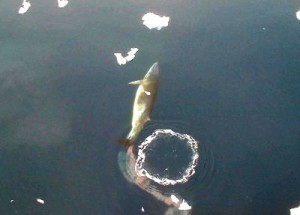Photo by J. Brokowski
© Commonwealth of Australia
I was told (as a young mother) that if you slap your child as you explain to her the causal relationship between fire and pain, this will expand her understanding of her relationship to fire. But does this method apply to expanding an individual’s world view from homocentric to ecocentric? Can a physical experience help us understand our connection to the environment as a whole living entity?
Perhaps a psychologist can explain my hunch that world views of individuals can be expanded when logical explanations are combined with sensory experiences.
Yesterday a most respected learned friend commented on my thesis. He said that he had read the first 100 pages and found a few typos, but found the thesis ‘well written’ with a ‘nice juxtaposition of pictures’. He assured me, when I asked, that the argument (as far as he had read) is clear.
However, he said two things that concern me. First, he said ‘This is not my universe’. Second, he said he could not open the animation files on the data disk.
When I explained that I had written simple instructions on how to access the animations, he told me that he always has trouble reading technical notes and, anticipating this, had passed over them. He told me that his mind goes blank when he sees technical instructions. I can relate to this, preferring instead to poke around and find things out my own way.
That my research does not describe my learned friend’s ‘universe’ suggests that the content of my writing (including technical instructions) does not and cannot expand his perception. However, he has not seen the animations. What a paradox that that his universe is made up primarily of words, and mine is made up primarily of sensations, and yet he could not understand the written instructions to view them.
This response reinforced my experience that changing habitual ways of doing things (including my own) is our greatest challenge! As Richard Dawkins has said (ABC Radio National, around 2005), the greatest challenge for a human brain is to understanding another human mind.
Can an arts-based research project succeed in satisfying all the requirements of a PhD yet fail to communicate the (essentially non-verbal) meaning in the art? My friend’s comments suggest that it can.
This thought momentarily plunged me into feelings of doubt about the value of art in communicating climate change information, let alone contributing to changes in perception or behaviour.
However, my friend had assured me of the value of good writing and presentation in at least getting a hearing from respected peers. He had taken time to look at my efforts. He provided honest commentary and presented his comments with respect for our different views of the world.
This assurance was reinforced further at the launch of a book (yesterday), co-edited by the AAD marine scientist, Knowles Kerry (See next post).
The AAD sends artists to Antarctica whose work can contribute to their ‘core business’. This business reflects the policies of federal ministers and their policy makers. AAD core business is protecting Antarctica as a vital part of the whole ecosystem.
Without resorting to sentiment or fear tactics, artists can make work that appeals to the senses to attend to scientific information. Art that is ecocentric (focused on the ecosphere) can literally make sense of data to provide a sense of the whole ecosystem.
Academic research (artistic and scientific) is vital for changing perceptions (world views). However, logical explanations can connect to people most deeply through the senses.

